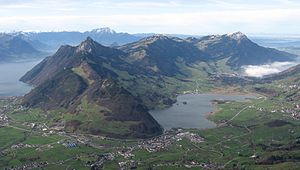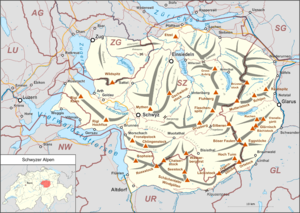Rigi
| Rigi | ||
|---|---|---|
|
The whole Rigi massif seen from the east, on the right with the Rigi Kulm antenna |
||
| height | 1797.5 m above sea level M. | |
| location | Central Switzerland | |
| Mountains | Schwyz Alps | |
| Dominance | 13.2 km → Niederbauen | |
| Notch height | 1288 m ↓ Goldau | |
| Coordinates | 678 784 / 211918 | |
|
|
||
|
View from the northwest |
||

The Rigi is a mountain range between the Vierwaldstättersee , the Zugersee and the Lauerzersee in central Switzerland . The highest peak is 1797.5 m above sea level. M. Rigi Kulm , a popular destination for tourists. The other peaks Rigi Hochflue (occasionally Hochfluh , according to the Swiss national map 1: 25,000 Hoflue ), Dossen, Rigi Scheidegg and Vitznauerstock (LU) = Gersauerstock (SZ) are slightly less high .
Surname
In humanism - for the first time in 1479 by Albrecht von Bonstetten - the name Rigi was traced back to the Latin regina montium, "Queen of the Mountains", which was intended to characterize the majesty and beauty of the mountain. In terms of linguistic history, however, this is not tenable. Rather, the name of the mountain contains the Swiss German generic word Rigi, which means «horizontal stratification , stripes, ribbon». Old High German * rigī is a derivation of Old High German rĩhan «umgürten; pleat, pull on a thread ».
The name can be found for the first time in a fairy tale description of the Küssnacht court dating back to around 1350 , on the one hand in a copy from the late 15th century: uff an den obresten grad rigen and one from 1561: uf then oberstenn grad Riginun . In the specific case, this refers to the mountain slope below the ridge that extends from the Kulm to the Rotstock. Further early evidence dates from around 1368: Küssnach in pede montibus Riginan "Küsnacht at the foot of the" Rigene "mountains" and from 1384: from the bergs, gimeinmerchs and güeter because of the riginen ob der Egg "because of the mountain, the common property ( Allmend) and the goods that are on the "Rigen" (ledges of rock and grass) above the Egg ». It is named after "the horizontally visible bands of rock and grass that surround the summit in a wide arc from west to east". The plural form Rigen , which was used throughout the 14th century and also repeatedly in the 15th century - after all , numerous "ribbons" are visible - is replaced for the first time in a document from 1439 by the singular Rigi , in which the transition from the generic word for the many grass and Rock bands become the name for the mountain and the whole mountain range.
The grammatical gender varies. In terms of linguistic history, the word and therefore the name is female . This usage has persisted in the local area to this day, otherwise it is often male . The name of the village Küssnacht am Rigi at the foot of the mountain proves that the masculine gender has been in use for a long time. This can be explained as based on Rigiberg .
tourism
Thanks to its good location on Lake Lucerne , the Rigi was already known as an excursion and holiday destination in the 18th century . In 1816 the first wooden guest house was built on the Kulm. This building was significantly supported by the Zurich panorama draftsman Heinrich Keller . More guest houses were built in the coming decades. In 1859, Friedrich Albrecht proposed a railroad up the Rigi, the gondolas of which were to drive up the mountain using gas balloons . In 1875 the Grand Hotel "Schreiber" with 300 beds was opened as the largest building to date in the summit area. This was demolished at the beginning of the 1950s and replaced by a smaller new building.
Visitors can enjoy a wonderful panorama over Lake Lucerne and the nearby Alps as well as to the north into the Central Plateau . The mountain also offers various leisure activities: hiking, sledding, skiing, cross-country skiing, paragliding, horse-drawn carriage rides, nostalgic rides on a steam locomotive from the turn of the century and much more.
In 2016, combined with a share increase, a plan for renovating the infrastructure was published, which aroused local residents' fear of an inappropriate development from the mountain experience to more consumption.
Public transport
The Rigi is accessible with two rack railways and several cable cars:
- from Vitznau : The Vitznau-Rigi-Bahn ( rack railway ) was put into operation on May 21, 1871 as the first mountain railway in Europe. It reached the summit in 1873 and has been operated electrically since 1937. VRB had to lease the route from Staffelhöhe to Kulm from ARB until the merger, as it did not have a license for this section of the route in Schwyz.
- von Arth : The Arth-Rigi-Bahn (rack railway) went into operation on June 4th, 1875. In 1907 this railway was converted to an electric drive as the first standard-gauge rack railway in the world. The original valley route from Arth am See to Goldau no longer exists, the train begins today at Arth-Goldau station .
- from Weggis : The Weggis-Rigi Kaltbad panoramic aerial cableway went into operation on July 15, 1968.
- von Goldau : The Kräbel Rigi-Scheidegg LKRS cable car went into operation in 1953, capacity was expanded in 1960 and 1985 and in 2017 it was replaced by a Garaventa “compact cable car ” with 15-person cabins from CWA.
- other, smaller cable cars run from Vitznau to the Wissiflue and to Hinterbergen, between Gschwänd and Burggeist and from Brunnen to the Urmiberg .
The first three systems mentioned merged in 1992 to form Rigi-Bahnen . The two rack railways use the same standard gauge tracks with racks according to the Riggenbach system and the same driving voltage of 1500 V direct current , so that vehicles can be exchanged easily.
The narrow-gauge Rigi-Kaltbad-Scheidegg Railway was built between Rigi Kaltbad and Rigi Scheidegg from 1874 to 1875 , but it only went into the black in a few years and interrupted operations several times. In 1931 operations were completely shut down, the rolling stock was sold and the route was canceled in 1942. On the route of this railway today, a comfortable hiking trail, which is also popular in winter, leads over bridges and through a tunnel.
There is also a dense network of hiking trails, the most important connections of which can also be used in winter. The belonging to the municipality Weggis LU, at 1400 m above sea level. M. lying settlement Kaltbad is the center of activities (station of the VRB, hotel facilities, post office, village shop, apartments, chapel.) The place is free of cars and also long been known as "the cold bath" known. A popular, almost flat hiking trail leads to the well-known Känzeli lookout point with a view of Pilatus , Lucerne and Lake Lucerne . The Kaltbad – First – Klösterli – Trib – Kulm – Staffel – Känzeli – Kaltbad trail or the high-altitude trail from Rigi Scheidegg to Rigi Kulm offer longer hiking options with more vertical meters.
photos
geology
Geologically, the Rigi, apart from the limestone pinnacles of the Hochflue , and the Vitznauerstock (in the canton Schwyz they are called Gersauerstock ) in the south, no longer belongs to the Alps , but to the subalpine Molasse and thus to the Swiss plateau . The rock, which is pressed together from different materials and is not very solid, is also known as Nagelfluh .
Heavy rain often occurs on the western and northern slopes of the Rigi . In places, they lead to severe soil erosion and in shallower areas to the deposition of often thick loose sediments mixed with humus (alluvium as colluvium ).
The Rigi in literature and art
The complete panorama of the Rigi was drawn (for the first time?) By Samuel Birmann in 1814/1815. William Turner captured the view of Lake Lucerne in a world-famous watercolor in 1842 ("The Blue Rigi - Lake of Lucerne - Sunrise").
In literary terms, the Rigi is best known through Mark Twain , who describes his experiences while climbing the mountain in his travel stories "A Tramp Abroad". Even Johann Wolfgang von Goethe visited the Rigi. In his work "From the diary of Prince Nekhludov: Lucerne", Tolstoy describes the view from up there as one of the most beautiful in the world. Alphonse Daudet starts his book “ Tartarin sur les Alpes” on Rigi-Kulm.
The “Rigilied” Vo Luzärn uf Wäggis zue from 1832 by the composer Johann Lüthi is a well-known Swiss folk song .
Chapel on Rigi Klösterli
Transmitter
Swisscom Broadcast AG operates a radio and television transmission system on the Rigi . There is a viewing platform at 6 m height of the 96 m high tower.
Personalities
- Josef Dahinden (* 1898 in Rigi-Kaltbad; † 1993), Swiss ski instructor, writer and filmmaker
See also
- Telecommunications tower Wuppertal-Küllenhahn , as a telecommunications tower Rigi-Kulm known
literature
- Erwin Horat: Rigi. In: Historical Lexicon of Switzerland .
- H. Kienholz, P. Mani, M. Kläy: Rigi Nordlehne - Assessment of natural hazards and silvicultural priorities. Interpraevent, Graz 1988, pp. 161–174, online as PDF (accessed December 1, 2009)
- Adi Kälin. Rigi: More than a mountain . Hier + Jetzt, Baden 2012, ISBN 978-3-03919-245-8 .
- Leo Tolstoy : From the diary of Prince Nekhludov: Lucerne . (Travel report)
Movie
- My first mountain - a Rigi film by Erich Langjahr from 2012.
Web links
- Official website of the Rigi-Bahnen
- Rigi Kulm (summit) on GeoFinder.ch
Individual evidence
- ↑ a b c Schweizerisches Idiotikon , Volume VI, Column 753, Article Rigi , meanings 3a and 3b.
- ↑ Lucerne name book 2. Rigi. The place and field names of the Lucerne Rigi communities. Edited and edited by Erika Waser, in collaboration with Alex Baumgartner and Peter Mulle. Gamma, Altdorf 2009, ISBN 978-3-906200-26-2 , pp. 377-379, here 378.
- ^ Section after: Lucerne Name Book 2. Rigi. The place and field names of the Lucerne Rigi communities. Edited and edited by Erika Waser, in collaboration with Alex Baumgartner and Peter Mulle. Gamma, Altdorf 2009, ISBN 978-3-906200-26-2 , pp. 377-379.
- ↑ Kurt Meyer : How do you say in Switzerland? Dictionary of Swiss peculiarities. Brockhaus, Mannheim 1989 (Duden Taschenbücher, Volume 22), p. 242; again in: Ders .: Swiss dictionary. That's what we say in Switzerland. Huber, Frauenfeld / Stuttgart / Vienna 2006, p. 214.
- ^ WH Vormann: From the Rigi-Kulm tourist books . BF Haller, Bern 1883, p. 9-18 .
- ^ History and technology of ballooning in "Measurement, Photogrammetry, Culture Technology", Volume 99, Issue 2, 2001
- ↑ History of the Rigi Kulm Hotel
- ↑ https://www.rigi.ch/content/download/6607/91623/version/2/file/RIGI+BAHNEN+AG+Emissionsprospekt.pdf OUR MOUNTAIN - OUR PLANS - JOIN US! - Rigi , issue prospectus of the Rigi operating company, 2016
- ↑ The house blessing hangs crooked on the Rigi , Luzerner Zeitung, October 16, 2017
- ↑ Technical data of the Kräbel Rigi-Scheidegg LKR cable car ( Memento of the original from February 6, 2015 in the Internet Archive ) Info: The archive link was automatically inserted and not yet checked. Please check the original and archive link according to the instructions and then remove this notice. rigi-scheidegg.ch (PDF file)
- ^ Regula Puskás: Lüthi, Johann. In: Historical Lexicon of Switzerland .
- ↑ My first mountain on www.langjahr-film.ch



















